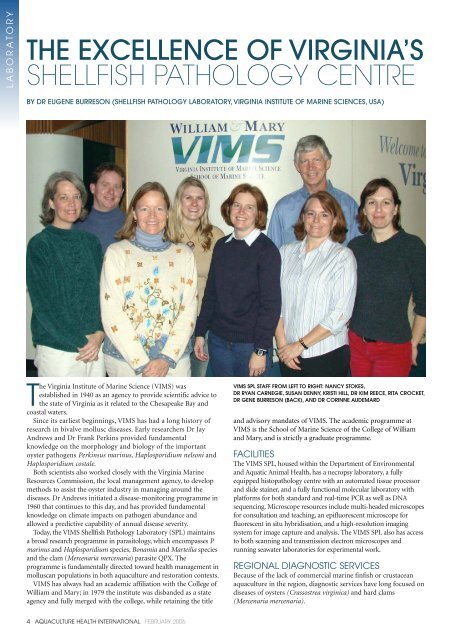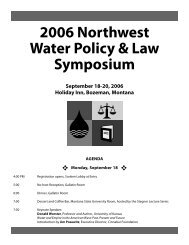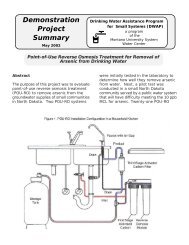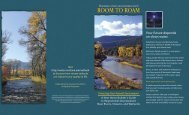aquaculturehealth - Montana Water Center - Montana State University
aquaculturehealth - Montana Water Center - Montana State University
aquaculturehealth - Montana Water Center - Montana State University
You also want an ePaper? Increase the reach of your titles
YUMPU automatically turns print PDFs into web optimized ePapers that Google loves.
LABORATORY<br />
THE EXCELLENCE OF VIRGINIA’S<br />
SHELLFISH PATHOLOGY CENTRE<br />
BY DR EUGENE BURRESON (SHELLFISH PATHOLOGY LABORATORY, VIRGINIA INSTITUTE OF MARINE SCIENCES, USA)<br />
The Virginia Institute of Marine Science (VIMS) was<br />
established in 1940 as an agency to provide scientific advice to<br />
the state of Virginia as it related to the Chesapeake Bay and<br />
coastal waters.<br />
Since its earliest beginnings, VIMS has had a long history of<br />
research in bivalve mollusc diseases. Early researchers Dr Jay<br />
Andrews and Dr Frank Perkins provided fundamental<br />
knowledge on the morphology and biology of the important<br />
oyster pathogens Perkinsus marinus, Haplosporidium nelsoni and<br />
Haplosporidium costale.<br />
Both scientists also worked closely with the Virginia Marine<br />
Resources Commission, the local management agency, to develop<br />
methods to assist the oyster industry in managing around the<br />
diseases. Dr Andrews initiated a disease-monitoring programme in<br />
1960 that continues to this day, and has provided fundamental<br />
knowledge on climate impacts on pathogen abundance and<br />
allowed a predictive capability of annual disease severity.<br />
Today, the VIMS Shellfish Pathology Laboratory (SPL) maintains<br />
a broad research programme in parasitology, which encompasses P<br />
marinus and Haplosporidium species, Bonamia and Marteilia species<br />
and the clam (Mercenaria mercenaria) parasite QPX. The<br />
programme is fundamentally directed toward health management in<br />
molluscan populations in both aquaculture and restoration contexts.<br />
VIMS has always had an academic affiliation with the College of<br />
William and Mary; in 1979 the institute was disbanded as a state<br />
agency and fully merged with the college, while retaining the title<br />
VIMS SPL STAFF FROM LEFT TO RIGHT: NANCY STOKES,<br />
DR RYAN CARNEGIE, SUSAN DENNY, KRISTI HILL, DR KIM REECE, RITA CROCKET,<br />
DR GENE BURRESON (BACK), AND DR CORINNE AUDEMARD<br />
and advisory mandates of VIMS. The academic programme at<br />
VIMS is the School of Marine Science of the College of William<br />
and Mary, and is strictly a graduate programme.<br />
FACILITIES<br />
The VIMS SPL, housed within the Department of Environmental<br />
and Aquatic Animal Health, has a necropsy laboratory, a fully<br />
equipped histopathology centre with an automated tissue processor<br />
and slide stainer, and a fully functional molecular laboratory with<br />
platforms for both standard and real-time PCR as well as DNA<br />
sequencing. Microscope resources include multi-headed microscopes<br />
for consultation and teaching, an epifluorescent microscope for<br />
fluorescent in situ hybridisation, and a high-resolution imaging<br />
system for image capture and analysis. The VIMS SPL also has access<br />
to both scanning and transmission electron microscopes and<br />
running seawater laboratories for experimental work.<br />
REGIONAL DIAGNOSTIC SERVICES<br />
Because of the lack of commercial marine finfish or crustacean<br />
aquaculture in the region, diagnostic services have long focused on<br />
diseases of oysters (Crassostrea virginica) and hard clams<br />
(Mercenaria mercenaria).<br />
4 AQUACULTURE HEALTH INTERNATIONAL FEBRUARY 2006






